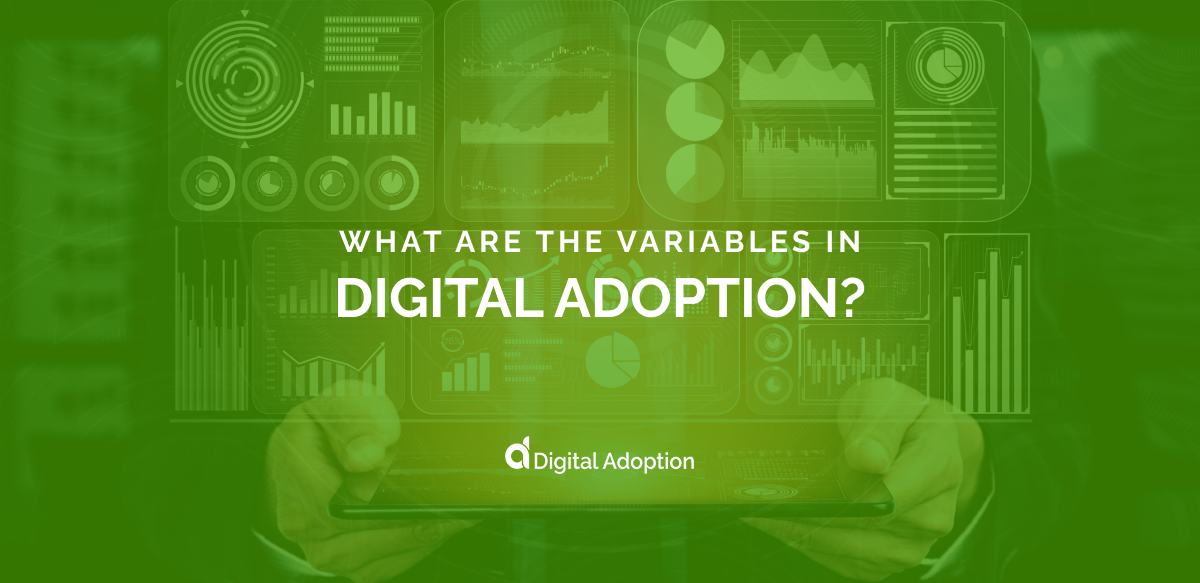What role do team members and culture play in the broader picture of digital adoption? What is the Digital Technology Readiness scale? What can we learn from the successes and failures of digital adoption strategies, past and present?
We can answer these questions by taking a detailed look at the variables of the digital adoption model. When we address these questions, digital adoption makes a lot more sense and can be used to its full impact.
There are times when digital adoption can feel like more of an art than a science. But following a thorough analysis of objective, peer-review research articles and other studies, it becomes clear that this is not the case. Digital adoption can easily be achieved through access to research, leading to a solid knowledge base on all digital adoption variables. First, let’s look at the five main variables of digital adoption.
- What Are The 5 Variables Of Digital Adoption?
- Factors That Affect Innovation Adoption
- Globalization & Technology Adoption
- The Digital Transformation Pyramid As a Conceptual Framework
- Diffusion Of Technological Innovation
- Digital Technology Readiness
- Digitization & Business Performance Amidst The Covid-19 Pandemic
- What Is The Digital Readiness Scale?
- The Econometric Approach
- What Are The Benefits Of New Business Opportunities?
- What Are The Benefits Of Business Cost Reduction?
- The Role Of Digital Technology Adoption In Strategy Renewal
- The Effects Of Digital Technology Adoption On Productivity
- Variables in Digital Adoption as Tools for Success
What Are The 5 Variables Of Digital Adoption?
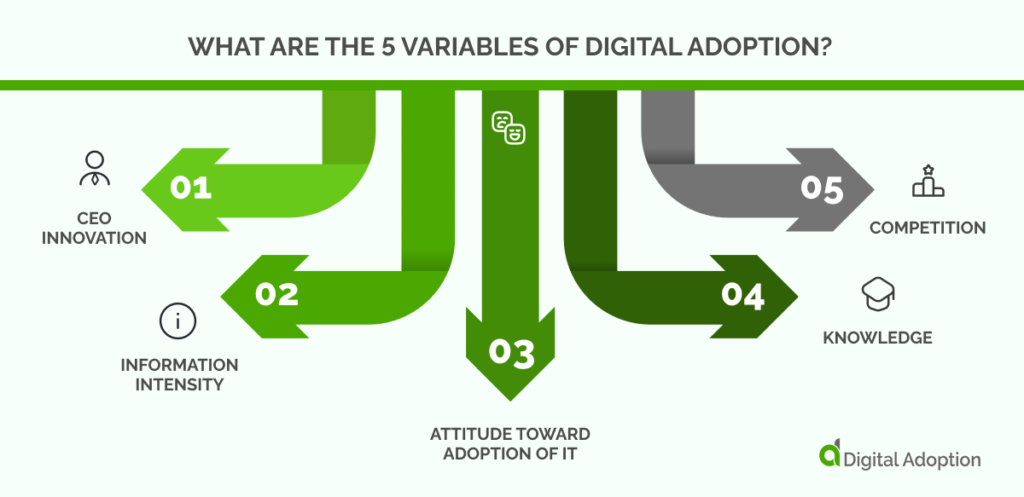
The digital adoption conceptual framework is split into five main variables; CEO innovation, information intensity, attitude toward adoption of IT, knowledge, and competition.
Let’s begin with CEO innovation. This variable is first because the CEO has the potential to become the core of change within a digital organization.
1. CEO Innovation
Innovation begins with the CEO of a company. As a figurehead of an organization, the CEO is responsible for inspiring innovation in team members at every level. CEOs also facilitate a culture of innovation via technology adoption and other means in each department that uses digital technology.
Diffusion of innovations (DOI) can then be cascaded down to CIOs and management staff to ensure a culture focused on the importance of innovation. CEOs are perceived with respect, maintain a strong relationship with team members, communicate effectively, and are familiar with their company’s relevant and current ICT literature when DOI is successful.
2. Information Intensity
Products define the Information intensity variable for any information technology company. The amount of information needed for a product for design, manufacture, advertisement, and transport to consumers is the product’s information intensity.
Information intensity also covers information management and information security, which is particularly crucial to how military forces fight technology wars. But this military context also has striking comparisons to business due to the need for constant technological advances and fending off aggressive competition.
Technology use is the core of information intensity, especially for companies dependent on digital technology. This is because it is the technology used in today’s digital world to record and store information. Appropriate investment in the technology adoption process and adapting technology to changing needs ensure effective information intensity.
3. Attitude Toward Adoption Of IT
An organization’s culture is essential to whether IT infrastructure and technology adoption is accepted or rejected. At the core of this is team members’ computer self-efficacy.
Self-efficacy is a team member’s ability to use computers and computer skills. Computer self-efficacy has a vast bearing on team members’ relationships with any new technology adoption process.
Communication is the key to success for self-efficacy. From team members to CEOs, managers to CIOs, views must be sought at every level to identify issues arising from implementing new technologies within a company.
Understanding, or lack thereof, can be a significant barrier to success for IT technology adoption. Understanding is considered part of the adoption of the IT adoption process, with every team member understanding what the new ICT technologies are and the reason for their implementation. Only then will team members use ICT tools effectively and cascade their learning toward colleagues.
The complexity or perceived complexity of ICT-related training programs can also lead to significant changes in how team members respond to a proposed digital technology adoption process. If team members see training programs as easy to access, the likelihood of success in personal and organizational development increases.
4. Knowledge
In a business environment context, knowledge is the information obtained via experience and training carried away by team members when they exit the company. Knowledge loss is hugely detrimental when knowledge and information management are carried out incorrectly.
Knowledge and information management are particularly crucial since The Great Resignation, the mass exodus of staff leaving job roles due to Covid-19. In an article for Gartner in 2022, Reul defined the scale of the problem of knowledge loss due to The Great Resignation and its consequences.
“Nearly three-quarters of CEOs expect a shortage of workers or skills to disrupt their business in the next year; half cite retaining talent as one of their biggest challenges. When employees leave, they take with them valuable institutional knowledge. Failing to capture these intellectual assets has costly repercussions.”
Evaluation and capturing of knowledge are possible when categorized into one of two forms: explicit and implicit. Explicit knowledge is found in records, data files, and other physical cloud locations. It is usually easy to capture and transfer.
Tacit knowledge, on the other hand, is experience-based. Loss of tacit knowledge is a significant detriment to the company, as it takes a long time to build up. So how can a company keep the knowledge held by its team members?
Reul (2022) proposes two actions in this article:
- Promoting a culture of continuous knowledge transfer
- Personal Productivity Tools (short to medium time frame)
- Storytelling (medium time frame)
- Contextual Inquiry (long time frame)
- Rewarding employees who help execute the continuous knowledge transfer.
- Encourage staff to join in with continuous knowledge transfer by tying it to performance expectations or by rewarding those who practice it with their chosen items.
- As part of a group performance review exercise, encourage employees to share situations in which their actions have fostered their coworkers’ skills or capabilities. Include the results in the annual review.
Although knowledge management can feel like a broad, complex topic that is difficult to manage safely, Reul’s actions promoting a culture of continuous knowledge transfer and rewarding employees who practice this can safeguard against knowledge loss. As suggested by Reul’s Gartner article, CIOs and CEOs see the benefits of demonstrating these actions.
5. Competition
Competition can lead to market stagnation and eventual company collapse. However, if reacted to correctly, the competition promotes access to innovation, growth, and success. The reason is that the behavior of a company’s competitors can inform future decisions and guide innovation towards the correct channels.
Competition not only helps drive success, but competition is often essential for success to occur. Monopolies in specific industries can promote arrogance and stagnation. Yet, SMEs, hungry for greater attention and marker gains, have a far greater incentive for growth simply due to the presence of competition.
Research shows this to be the case, particularly for SMEs within developing countries. A 2021 research article with a total sample size of 480 SMEs in the Philippines produced findings expressing a relationship between SME innovation and competition.
This relationship proved that “when faced with high degrees of competition, SMEs are more likely to innovate.” The two main aspects of business that showed a high correlation between the innovation and competition improvement were the production process and improvements to marketing categories.
However, if innovation is not implemented correctly and planned adequately, including contingency features, competition can be detrimental, to the point that a company can fail and collapse. Therefore, the competition must always be at the forefront of the mind of CIOs and CEOs when planning and cascading new strategies.
Factors That Affect Innovation Adoption
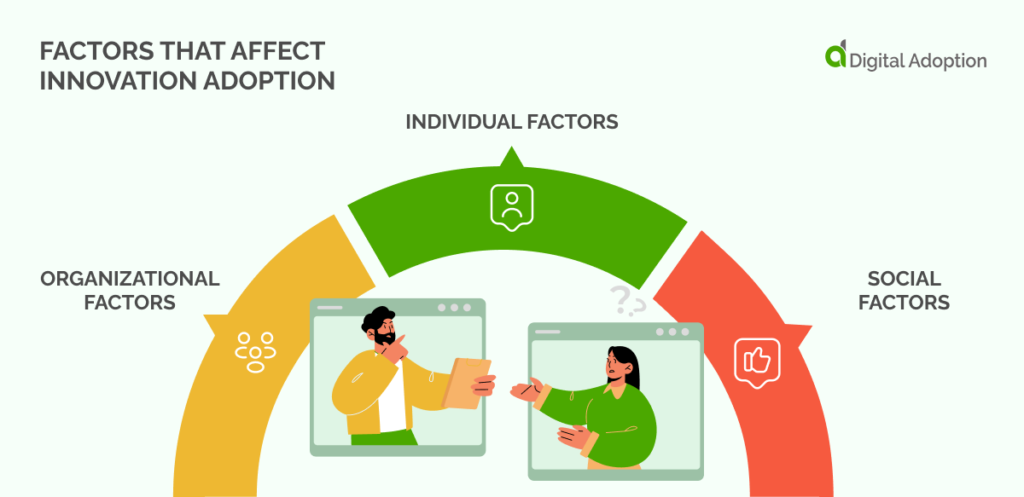
Factors affecting innovation adoption are split into three categories—organizational, Individual, and Social. The first in this list is organizational factors.
Organizational Factors
Whether SME (Small or medium enterprise of fewer than 250 people) or large enterprise (250+ people), the size of an enterprise has a significant bearing on innovation adoption. The larger the company, the more difficult it can be to shift culture toward a new technology adoption process.
The philosophy of an organization toward failure can also be detrimental or helpful in fostering innovation. Some companies, especially in the creative sectors, frequently encourage their employees to fail to learn and develop sooner. The result is an increase in innovation at an organizational level. Individuals are encouraged to conduct their innovation, cascading this experimental approach and lessons from this process to others, facilitating conditions for innovation.
Another significant factor, alongside many other organizational factors, is resources. In emerging markets, one term has come out on top to facilitate conditions for innovation to occur in resource-scarce organizations. Frugal innovation.
Frugal innovation is the innovation of companies within emerging markets that meet the needs of consumers on lower incomes. Such consumers desire to possess items of a certain quality but will accept a certain lower quality up to a specific point. Frugal innovation within emerging markets meets such needs in India and other Asian countries.
One such comprehensive literature review study on frugal innovation found that the data collected confirmed the hypothesis; that frugal innovation leads to value for money, acceptable quality, scalability, and marketability. The study also found extra benefits to frugal innovation, such as frugal innovation leading to higher technical novelty and higher market novelty, meaning that reduced resources can even increase innovation in this respect.
Aside from frugal innovation, systems within larger organizations play a significant role in the innovation implementation of an organization. For example, the limitations and details of the law system of different countries in intellectual property law and the presence of trained professionals to navigate this are essential as a systems-based variable.
Another example is the ability of the education system of a nation to supply appropriately trained professionals to fulfill roles within an organization. Systems-based variables must therefore be considered when planning an innovation adoption strategy.
Individual Factors
The most significant factor within digital change adoption is the individual. Individual team members carry out the innovation adoption to achieve digital transformation. Without adequate training, personal empowerment, incentivization, and excellent communication channels at all times, digital innovation adoption will fail.
Findings that evidence this point can be seen in a study published in March 2021 by Tann, who was trying to discover the ‘change agent,’ the agent that can begin the process of innovation within organizations. Tann found that different team members holding different roles are essential to the innovation process.
These roles are described in order of the process within which they fulfill their role as “Strategist, change-catalyst, transactor, builder, innovator, processor, coach,” and “communicator.” Successful innovation can occur and crucially become embedded when these different roles are present.
If this is taken note of and team members fulfill these crucial roles within innovation adoption, the likelihood of success in facilitating conditions for innovation is increased. That said, few studies or research articles exist on the conditions which initially spark the ideas for innovation, so further research in the future is required.
Social Factors
Social factors related to digital adoption and digital transformation primarily relate to public attitudes and beliefs. Of these attitudes and beliefs, one of the easiest to analyze and measure is public attitudes toward new technologies.
In the 1920s, in North America, it was difficult to persuade residents to get a phone line put in, as many didn’t feel it was needed. Representatives were hired to go door-to-door to talk to people about this essential new infrastructure and convince them it would be affordable and beneficial.
Social media is a massive determinant of what is popular and what values certain groups hold in society today. Analysis of social attitudes via social media and posts related to popular keywords can inform innovation decisions. For instance, ten years ago, vegan food products were low in popularity. Today, veganism is a much more mainstream lifestyle choice with many options.
With the accessibility for anyone to create meme content and other types of content, social media popularizes lifestyle choices. If companies can tap into and predict such social trends, innovation can be driven toward a higher likelihood of success.
Globalization & Technology Adoption
“Business leaders in most European countries — including Portugal, Spain, Germany, the U.K., France, Italy, and Sweden — prioritize client retention over acquisition in 2021.”
As shown by the above quote from an article on the varying needs and priorities for software in different parts of the world, the digital landscape varies dependent on the values of society in each continent and country. This article explains what is meaningful to European buyers and what is considered when selling software to these nations.
For instance, “78% of European businesses say user reviews were important before making a software purchase decision.”. This shows how some countries perceive the quality and efficacy of a software product, whereas “in Brazil, buyers want more technical information than anything else.”
This statistic shows that in South America, the priority when considering the software as part of a technology adoption process is to prioritize the software features before purchasing and accessing a product. There is a contrast here with Europe, where questions asked when purchasing software relate to how other companies and customers perceive software quality.
In a McKinsey article, Asia-Pacific markets have adopted digital banking at a sharply increased rate. This increase is most likely to result from the effects of Covid-19 expanding the necessity of technology adoption by consumers, especially video-conferencing as people work from home.
This consumer technology adoption has allowed developing countries in Asia-Pacific markets to have caught up to more developed countries, showing how globalization leads to greater technology adoption through the attitudes technology can change globally.
The Digital Transformation Pyramid As a Conceptual Framework
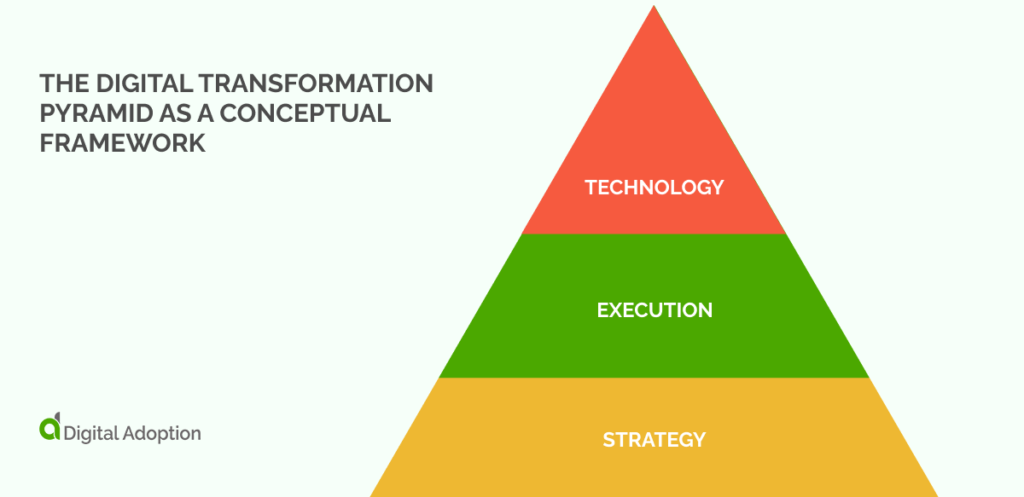
“When it comes to digital transformation, digital is not the answer. Transformation is.”
George Westerman, Senior Lecturer, MIT Sloan School of Management and Principal Research Scientist
To elaborate on Westerman’s point, it is not technology that drives digital transformation but people. Team members must adopt, adapt and implement technology in a meaningful way. The technology adoption process is useless without people and positive attitudes toward digital transformation strategies.
When it comes to the most useful conceptual framework used to examine the complexity of digital adoption variables, the Digital Transformation Pyramid (DTP) is critical. The objective of the pyramid is to help break down and simplify the variables into three layers; Layer One is Strategy, Layer Two is Execution, and Layer Three is Technology.
Layer One (Strategy)
At the top of the pyramid is the most straightforward layer. Business targets and corporate objectives are defined.
Layer Two (Execution)
Business objectives are carried out. This layer represents a more complicated set of processes, but these can are into three simple sub-sections, all essential for successful business execution; Operating Models, Infrastructure, and Go-To-Market.
Operating Models: Organization, Process, Tools (Internal)
Organizational factors are significant here as the processes followed and the tools used to carry out procedures.
Infrastructure: Manufacturing, Supply Chain, Logistics, Planning (Internal)
All of the above features are essential for the infrastructure to be effective.
Go-To-Market: Product, Customer (External)
A product can only be considered ready for consumption by the public when the above processes have been checked-off and followed. At this point, services and products leave the inner confines of the company and head out into the vast unknown.
Layer Three (Technology)
The bottom layer of the pyramid is the technology used by any company, whether services or products sold are related to information technology or otherwise. This fundamental layer represents the core of any business environment today, needed for all daily operations.
This layer can also be considered for using technology for efficiency savings to reduce overheads. Examples of such technologies are ERP, CRM, and Big Data analytics.
The DTP is an excellent and essential tool used by CEOs and CIOs for planning and implementing a digital transformation strategy. The DTP framework can provide overarching guidance throughout every part of digital transformation to ensure success, efficiency, and value for money.
Diffusion Of Technological Innovation
“Diffusion is the process by which an innovation is communicated… over time among the members of a social system.”
Rogers, Diffusion Of Innovations, 2003
Diffusion Of Innovations (DOI) is a conceptual framework taken from Rogers’ theories in his 1962 book Diffusion Of Innovations. In this book, Rogers describes DOI as the reason, rate, and nature of technological innovation as it moves through cultures at the organizational level. In simple terms, diffusion describes the movement of ideas throughout a social system.
Certain groups are said to absorb new ideas before others, and this is where Roger’s theory is crucial to business leaders and CEOs. Innovation can be focused on specific groups of individuals, sparking innovation over time.
Social media dictate today’s social systems and internet networks, all experienced via the metaverse and the IoT (Internet of Things). For example, an innovative new product, the first generation of Samsung Galaxy Flip smartphone, might be given by a company to social media influencers to use and review.
Rogers would describe these influencers as the Innovators. Children, young adults, and younger working-age people in Western countries, with an assumed amount of disposable income, will then view the coverage of the product and purchase it (Early Adopters).
From this point, the young people with the flip smartphone will use it for a certain period of time and then, once they are experienced using it, will tell their parents (Early Majority), who will tell grandparents (Late Majority). This group buys this product for themselves, and this is where sales peak.
Finally, the peak begins to dip as the technology ages, as it is sold more cheaply, at which point the Laggards purchase it. In this way, innovation is diffused throughout a social system, and a new product becomes the social norm, and a Samsung Galaxy Flip can be found in every pocket.
In this way, Roger’s theory of DOI, initially stated in 1962, can be used to powerful effect today when applied within a technology adoption strategy aimed at selling a new product to the consumer market.
Digital Technology Readiness
“Technology like art is a soaring exercise of the human imagination.” Daniel Bell, author, The Winding Passage: Essays and Sociological Journeys, 1960-1980
Daniel Bell is not a figurehead of the IT business environment, nor is he the CEO of a large, multi-billion dollar company. But what he illustrates here is infinitely valuable within Digital Technology Readiness (DTR). Bell demonstrates that the technology adoption process for individuals within a society can be seen as a positive, exciting endeavor.
When this perception is shared by many, a technological breakthrough can be hailed as a success for society and business. The Cloud is the next epoch of the current times, revolutionizing the way data is processed and stored. However, not all companies utilize the cloud, which puts them at a disadvantage. There could be many reasons for this lack of digital technology readiness, some of which can be a lack of organizational and digital readiness.
Organizational & Technological Digital Readiness
Most of the organizational variables related to DTR cover planning and culture. Firstly, let’s look at planning. A list of desired benefits of new technology such as reducing human inputs, efficiency increases, the potential for agility, and improvements to product quality is written. When this is achieved, planning needs to incorporate potential obstacles to DTR.
Potential obstacles to organizational DTR can include factors like:-
- Difficult financial conditions (liquidity vulnerabilities, huge investment needs);
- Talent pool limitations (too few ICT specialists or multi-skilled team members);
- Information and knowledge barriers relating to other factors, such as unknowns regarding the performance or future technology business disruption; organizational and managerial barriers (team members unwilling to adopt new technology; lack of awareness of management team on the plusses of new technologies)
- Sunk cost barriers refer to the substitution costs firms have to incur in order to introduce the new technology—for example, incompatibility between existing organizational operating systems and new proposed technology adoption.
The plan for desired outcomes and noting and planning how to tackle potential obstacles to DTR form a good strategy for taking on the organizational factors of digital adoption.
A prime example of where such digital technology adoption was implemented successfully is for SMEs and The Cloud. The use of The Cloud has leveled the playing field for SMEs against larger enterprises. This is due to planning for desired outcomes and obstacles to these outcomes, and the availability of inexpensive, tailored technologies via SaaS (Software as a Service) in the past decade.
Environmental Readiness
When considering the importance of environmental readiness for digital technology, we must look to CIOs to coordinate this, suggests Rimol (2021), writing for Gartner. Rimol separates environmental readiness into four categories. The first of these revolves around rethinking working methods.
- Rethink how work is done
In the past, the open office reigned supreme. However, in today’s business environment, personal privacy and concentration can be essential to productivity with technologies such as email and reliance on smartphones and computers. Different areas, some open for team brainstorming, some group rooms for private discussions, and some more individual privacy-focused, can be designed with other functions in mind.
- Address psychological needs
Humans have social needs and need to feel socially linked to others, in and outside of work contexts. In a technology-oriented workplace environment, this can be a complex juggling act. Too much or too little social engagement can impact well-being negatively. CIOs are best placed to ensure people stay connected in a helpful way via connection strategies.
- Reimagine the use of office space
Workplaces are changing to workspaces, with the alterations to everyday life resulting from the Covid-19 crisis. The workplace paradigm shift is a fact that CIOs need to become mindful of in configuring office spaces. The complexity of this is that some team members enjoy working in a digital workplace environment within a physical office, as office workspaces and home workspaces all need to be acknowledged.
Navigating the complexities of hybrid and remote working can be difficult. Needs can vary for each team member and whether current technologies and systems meet their in-office/ out-of-office scheduling and room booking requirements. Taking the time to become aware of these needs and maintaining an open, flexible approach are essential practices to help any CIO meet environmental needs.
- Manage integrity and risk
The prioritization of integrity and risk are of higher importance in hybrid working environments. This is largely due to the importance of security, which is more difficult to control outside an office environment. However, other issues arise from work-from-home arrangements, such as monitoring of team members.
For all issues relating to security, confidentiality, credibility, and liabilities, all CIO team members should thoroughly research before creating and implementing policies. Contingency plans should also be included for unexpected events such as power outages.
4 Ways For CIOs To Implement Hybrid Working, Gartner
Digitization & Business Performance Amidst The Covid-19 Pandemic
“COVID-19 has catalyzed the need for innovations. Makers Asylum in India has developed an inexpensive face shield kit priced at INR 55 ($US 0.73), one-third of the average market price (Radjou, 2020).”
Emerging markets in developing countries are forced to innovate to generate profits and avoid collapse amidst Covid-19. But more established markets are also being dramatically affected by the Covid-19 crisis.
Before Covid-19, all businesses in every nation faced ever-pressing digital technology adoption and transformation needs. Companies are now responding to Covid-19 by leveraging digital transformation, especially Industry 4.0, at a higher rate than initially planned to combat losses in the future. Industry 4.0 is split into four elements:
- Connectivity, data, computational power – Sensors, IoT (Internet of Things), Cloud technology, and BlockChain
- Analytics and intelligence – Advanced analytics, machine learning, AI (Artificial Intelligence)
- Human-machine interaction – Virtual and augmented reality, robotics and automation (collaborative robots, AGVs), RPA, chatbots
- Advanced engineering – Additive engineering (e.g., 3D printing), renewable energy, nanoparticles
Imagining Industry 4.0, Gartner
Thirty-nine percent of companies within Agrawal et al.’s study “have implemented a nerve-center, or control-tower, approach to increase end-to-end supply-chain transparency. Around a quarter are fast-tracking automation programs to stem worker shortages arising from COVID-19.” This shows the impact of Covid-19 on speeding up digital technology adoption.
However, despite the need for Industry 4.0 technologies, profits have already been affected negatively by Covid-19, leading to what Agrawal et al. describe as an “asymmetry of technology adoption.” This is a detachment between the technology needed for growth within the next normal and a loss of the investment capital required to invest in such technology.
As a result, many companies are being more conservative with spending due to fears of further losses. Therefore, it is clear that companies need to be astutely aware of the need for digital technology adoption in preparation for Industry 4.0 while weighing up the risks to the implementation of significant investment.
The Industry 4.0 model caters only to the concrete processes of business: design, production, and logistics. But what about the human sides of a business and how they are affected by Covid-19? Yokoi and Jordan, writing for Harvard Business Review, suggest that the prevalence of hybrid working calls for a shift in the paradigm of communication.
The use of emojis by team leaders allows team leaders to note team members’ feelings in a more authentic way in place of body language that cannot be seen when working from home. The following benefits of emoji use by team leaders are proposed:
- Deeper insight into team feelings
- Chance for team leaders to build cognitive empathy
- Model appropriate emotions
- Reinforce company culture
HBR, Using Emojis To Connect With Your Team
These benefits emphasize the point that human aspects of technology use in business are just as significant as the technology used for more concrete outcomes. This is because soft skills have the potential to have just as much impact on company outcomes. Such an approach is reinforced and advocated by business leaders such as Eduardo Morales, Dansk Bank product owner, and Lori Gettelfinger, DuPont’s global brand leader.
In these ways, via Industry 4.0 and the use of emojis for communication, technology has increased in prevalence as a reaction to the Covid-19 outbreak. This shows yet another context in which technology transformation strategies are essential to optimal business practices. Industry 4.0 is now a recognized model and will likely be prevalent in future research, transforming government policy and business practices through the association between digitization and the Covid-19 crisis.
What Is The Digital Readiness Scale?
Statistics and analytics are helpful as a part of a data-driven approach, taking dependent and independent variables, discerning where a business is located, and if it is heading towards success. The Digital Readiness Scale attempts to quantify one aspect of digital adaptability: a company’s readiness for the digital technology adoption process to achieve this success. One way this is achieved is through the econometric approach.
The Econometric Approach
“Competitive insights and analytics are what marketers need to progress to higher levels of maturity, understand ROI, inform investments and optimize campaigns in real-time,” Joseph Enever, senior research director, Gartner for Marketers.
Econometrics is the practice in which statistical models examine current data to form predictions for the future. The data taken from the econometric approach are used to predict phenomena such as consumer habits.
The economic departments of universities produce this data, then disseminate it for the world of business to access. Most commonly, such data is used by marketing departments of companies to maintain an agile and adaptive outlook. But similar data can also be used by government legal departments, transforming government policy through change and development informed by data.
As laid out in the Gartner CMO Spend Survey 2019-2020, 13% of the surveyed enterprise’s marketing budgets were spent on competitive insights and 16% on marketing analytics. This shows that econometrics is considered enormously significant within today’s business environment.
Four marketing methods exist to make sense of econometrics and decide how to get the best out of data.
Marketing Mix Modeling (MMM)
- Top-down methodology implementation
- Uses time series, aggregate data (such as historical sales), aggregate media spend by channel or geography, competitor promotional events or pricing, and econometrics techniques (like multivariate regressions) to generate models.
- They are used to inform multichannel marketing investments, generating a broad range of insights, like sales and revenue incrementality.
Multi-Touch Attribution (MTA)
- This bottom-up approach requires user-level data to identify the relative contributions of consumer touch points along the path to a goal.
- Digitally driven
- Primarily a methodology for online marketing analysis, it can also include multichannel events, depending on the available data and provider.
- It gives marketers the ability to track an individual’s path to conversion across multiple touchpoints, such as paid search, display, and video.
Holdout Testing
- Referred to as test and control, this is a crucial method for testing hypotheses.
- When conducted properly, marketing leaders can utilize holdout testing to accurately quantify the incremental impact of marketing investments across channels and tactics.
Unified Measurement Approaches (UMA)
- Answers questions that span both the tactical and strategic impacts of marketing.
- These approaches attempt to resolve the challenges of disparate, unlinked methodologies and insights.
- Marketing leaders looking to understand the impact of online and offline marketing should use this approach.
Several of these methods are used in tandem within a single process due to the complex needs of larger enterprise companies. However, econometric measures should always be used alongside other measurement methodologies.
Digital Readiness, Barriers & Digital Adoption
Econometrics bear close relationships to DTR, as statistics can be used to predict what technology adoption may be needed within a given time frame. One example of this is how video game development studios can forecast and use data to predict when a new gaming console will be released. New gaming consoles are usually released every five years, so game studios can plan around this, investing in digital transformation strategies in time for the latest technology.
A digital transformation strategy must be constructed at such times, as games will need to be made on entirely new technology. Infrastructure for larger studios will need to be re-built around such developments. However, barriers exist to such a transformation. Planning is required to accommodate the three components of this process: culture, process, and technology.
Organizational culture, especially for larger enterprises, is a complex phenomenon. It requires knowledge of individuals of each department and the association they make to working culture or cultures. All team members must be kept abreast of developments in digital readiness strategies and be given opportunities to give feedback. Problems may arise, such as hesitancy toward adopting new technology, but this can be easily managed.
Planning must occur at the process stage to meet goals. This may pose a problem, as the process of digital readiness can often be a lot more protracted than initially planned. As long as there is experience within the team on DTR or consultants ready to give their input, any variables affecting the time frame should be accounted for.
The final stage is implementing technology, which is a far more expansive barrier to DTR than the previous barriers of culture and process. Digital technology adoption today is rife with competition and diversity, which can overwhelm team members, as many use a large number of different pieces of software throughout their day.
The answer is to receive input from specialist ICT software technicians or consult with those who create the software themselves. When company systems integrate digital technology adoption strategies, trialing different software options with team members and reacting constructively to team member feedback can also yield long-term benefits to DTR.
Digitization & Business Performance
CEOs are usually the focus when it comes to the association between digitization and performance improvement variables. This is because CEOs are charged with assessing and overseeing metrics and implementing and coordinating any measures needed for progress and growth within their enterprise.
Respected McKinsey partners Fitzpatrick and Strovink suggest five methods by which a CEO can obtain a broad measure of success in a digital environment.
- Return on digital investments
- Percentage of annual technology budget spent on bold digital initiatives
- Time to market for digital apps
- Percentage of leaders’ incentives linked to digital
- Top technical staff attracted, promoted, and retained
Five Metrics for CEOs, McKinsey
When a CEO has become familiar with these measures, they can be adapted and made more appropriate for an individual company. Although department leaders are most often the team members recording the measurements, the CEO must always have respect and an awareness of all such measurements recorded by all departments. This is significant for success.
Armed with this knowledge, an effective CEO can use data to tweak the methods for attracting talent, staffing resource reallocation, and positively influencing the working environment culture. This will ensure innovation is implemented with optimal results for all types of organizations.
What Are The Benefits Of New Business Opportunities?
When variables of digital adoption are considered, there are many benefits for new business opportunities. The Digital Transformation Readiness (DTR) model or the Digital Transformation Pyramid (DTP) model can prepare businesses to undertake new opportunities.
Many companies are hesitant to adopt the metaverse as a technology and business opportunity, as it is so radically innovative and represents a high investment risk. Due to its cutting-edge nature, DTR can easily be applied to the metaverse as a business opportunity. Evidence for econometrics is clear, as in 2021, search results for ‘metaverse‘ increased by 7,200%.
Via this example, it can be seen that there are considerable benefits to DTR and DTP being implemented early to prepare for new business opportunities such as the metaverse, to massive gains. For those adopting and investing in the metaverse early, profits have risen quickly. Companies such as Facebook (now renamed Meta) and Epic Games have contributed to the metaverse as a global value creation opportunity potentially worth trillions.
What Are The Benefits Of Business Cost Reduction?
For any company to stay viable and profitable, costs must be calculated and reduced. Cost Reduction Initiatives (CRI) are effective ways of recording and reducing costs to ensure viability and profitability for the future.
Cost Control Towers (CCT) are at the center of many CRIs today. These “help companies set standard processes for cost-reduction efforts, increase cross-functional team collaboration, and help resolve many program-management challenges.” How CCTs function can be divided into problems and the digital adoption solutions they provide. Four examples are listed below.
Problem 1: Functions manage CRIs, and data from each group aren’t readily available to all program stakeholders
CCT Solution 1: CCT serves as a “single source of truth” and provides a common operating picture across each program
Problem 2: Functions are hesitant to implement new CRIs because owners fear not meeting their savings targets; leaders never learn about CRI opportunities
CCT Solution 2: CCT allows owners to assign weight to initiatives based on the likelihood of success; ratings are considered when quantifying success
Problem 3: Each function sets its cost baseline and may revise it, making the program’s starting point unclear
CCT Solution 3: Finance team owns a single, detailed cost baseline
Problem 4: CRI-review and customer-affordability meetings focus only on tracking progress
CCT Solution 4: The model introduces a cadence of weekly CCT and monthly steering-committee meetings to create accountability, ensure appropriate resources and enable cross-functional problem solving
Using a Cost Control Tower to Control Affordability In Defense, McKinsey
As an accountability boost, companies will benefit from CCT by connecting cost-reduction targets and improving cross-functional problem-solving. Examples of such companies that may need CCTs are defense companies due to the need to reduce costs due to consumers wishing to reduce defense budgets and the restraints of function-based organizational structures.
The Role Of Digital Technology Adoption In Strategy Renewal
“Now is the right time to adopt a test-and-learn mindset, to be open to experiments in the metaverse, and to move on quickly from failure and capitalize on success.”
Strategy renewal is how a strategy is changed, adapted, and renewed over time. There is no better example of agility and adaptability being needed for an emerging market than the metaverse.
Technologies like rapidly-evolving VR headsets and NFTs present new marketing opportunities. However, many companies are hesitant to adopt the metaverse as a platform, much as companies were hesitant about investing in the internet in the 90s.
In their article on the Metaverse, Agrawal et al. (2022) present guidance on creating a robust plan for strategy renewal within a digital adoption strategy. Four main actions are highlighted in this guidance—experimentation, partnership, planning risks, and rethinking success.
Experimenting with money-making models is the first action within the article. An example of this within the metaverse is that “direct-to-avatar sales of virtual goods are already a $54 billion market… Forever 21, for example, sells a beanie in Roblox for under a dollar. On the other end of the scale, Gucci sold a digital version of its Dionysus bag last year for $4,115—more than the price of the physical item itself.”
This shows how taking risks and seeing what works and what doesn’t via trial and error on new platforms can yield excellent financial returns. However, results are not always as desired. One way to spread risks and increase the diversity of products to remain novel and agile is to partner with other companies.
The second action is creating, leveraging, and partnering with other companies for new capabilities. Within the metaverse, any brand must focus on skills required and skills already possessed, then give the role of ‘coordinator for developing and executing a value capture strategy to a new or existing team member.
Any brand should seek to collaborate with other brands, including independent development studios, influencers, and creative communities that may be active on social media platforms such as Dribble or YouTube. Many celebrities have already successfully utilized the metaverse, such as artist Snoop Dogg, who created a music video that takes place entirely in the metaverse to great praise.
However, not every venture yields the intended results. This is why the third action is to proactively plan for risks to the brand. And there are few greater high-risk activities than engaging with consumers directly online.
Without planning and preparation for the rapid reaction caused by feedback loops and the viral nature of the internet today, engaging directly with consumers online can be catastrophic to brand image. The metaverse increases these risks due to the real-time creation and consumption of services and products.
To protect against these risks, Agrawal et al. (2022) created basic rules of engagement. These are specific policies and enforcement practices that can be followed later; for customer experience metrics, intellectual-property management, user safety, data privacy, and misinformation.
Even with the metaverse in relative infancy, disasters have already occurred. For one electronics brand, a product was announced with much anticipation. Still, due to problems gaining access to the item within the metaverse, users had to queue to get hold of it virtually. This brings us to the next point of redefining success.
Rethinking how success is measured involves a complete review of success metrics. The metaverse is not like any previous marketplace that has come before, mainly due to the rapid reactions to services and products acquired or consumed in real-time. Another factor is the scarcity of NFTs, as they are each unique.
Agrawal et al. (2022) suggest new metrics for measuring success in the metaverse. “The number of visitors, conversions, “likes,” and shares, as well as the cost of acquiring customers.” One example of the success of new logistical ideas in the metaverse came in a collaboration between Nintendo and Deliveroo.
Deliveroo deployed virtual deliveries of the Animal Crossing game, including codes to activate the game in real life. In just hours, three million player interactions occurred during this promotional event. It is, therefore, apparent that measurement tools for success will need to be re-invented entirely for use within the metaverse due to this being such a different environment, technologically and culturally.
In the ways described above, using the metaverse as an example, digital technology adoption within strategy renewal is much more complex than in any other environment. To remain innovative and agile, experimenting, partnership, planning risks, and rethinking success are essential to renewing any digital technology adoption strategy.
The Effects Of Digital Technology Adoption On Productivity
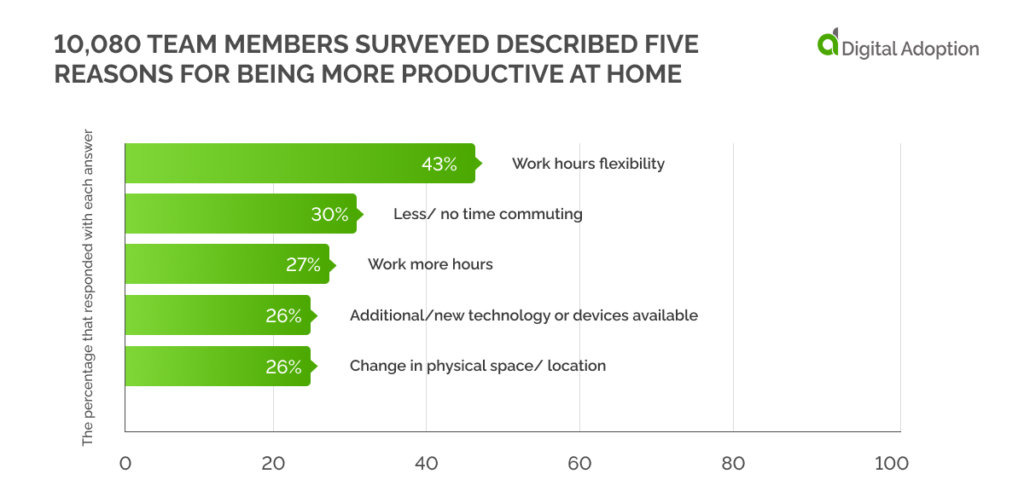
“A Gartner survey of more than 10,000 digital workers from the U.S., Europe, and APAC shows that workers in that segment are likely to feel that flexibility is key to their productivity.”
One of the significant industry changes in the past two years is the workplace environment shifting from office to home. This is one of the most radical paradigm shifts for decades, and many workers describe this as the main factor behind their productivity.
To add to this, many hybrid workers stated in the survey for Gartner that they feel working in an office with team leaders did not allow them to communicate any more effectively. Surveyed team members also stated they did not feel communicating with team leaders in person allowed them to be any more productive.
Digital Workers Say Flexible Working Is Key to Their Flexibility, Gartner
When digital technology such as Zoom software and high-quality webcams and microphones were used, 10,080 team members surveyed described five reasons for being more productive at home (the percentage that responded with each answer is in brackets):-
- Work hours flexibility (43%)
- Less/ no time commuting (30%)
- Work more hours (27%)
- Additional/ new technology or devices available (26%)
- Change in physical space/ location (26%)
Note the presence of technology adoption as one of these top five answers, showing that technology adoption dramatically impacts productivity. Therefore, it is clear that if higher well-being means higher productivity, the greater the investment in technology adoption, the higher productivity will become.
Variables in Digital Adoption as Tools for Success
Conclusions can be drawn following research analysis from trusted business education sources hosting peer-review articles such as ACM digital library, Gartner, and McKinsey. Firstly, as in any element of business, innovation via education and training are vital variables within digital technology adoption.
Secondly, innovation is possible via frugal innovation as part of a digital technology adoption strategy utilized in many emerging markets in developing countries. Implementation of frugal innovation occurs in ways that offer advantages over high-budget innovations, as novelty increases with frugal innovation. More can be accomplished with less.
Technological developments and their relative flexibility and low cost also allow companies in developing countries to innovate more efficiently. The Cloud and SaaS within a cloud transformation strategy are examples of this.
And thirdly, there are several different frameworks, such as the Digital Transformation Pyramid and the Digital Readiness Scale, used to plot a path to success via technology adoption.
Success can be achieved only when all of these variables are utilized as tools. However, without one final component, all other variables, no matter how much is invested in technology adoption, fall flat.
Team members remain the bedrock of every innovation, technology adoption strategy, and cultural change. Team members need to understand, operate, and maintain these technologies despite pressures to increase spending on Industry 4.0, Artificial Intelligence (AI), machine learning, and many other hardware and software advances.
For this reason, the soft skills of communication, empathy, and understanding are essential to team leaders, CIOs, CEOs, SODs (sales operation directors) and anyone in a position of authority. When excellent, compassionate communication is practiced and role modeled at every level, team members in more fundamental roles will also communicate effectively. CEO attention to employee experience management is essential to developing a successful business.
With such a high quality of communication up-scaled in such a fashion, a culture of embracing change and business technology adoption can thrive. This change leads to increased productivity, innovation, sales, and success. Culture, communication, and compassion are presented as the most fundamental and essential variables to successfully achieving digital adoption.

